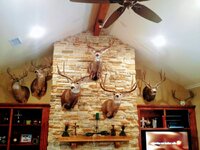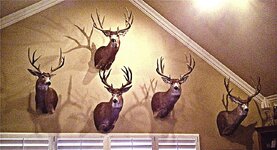Good explanations. Thanks. I understand what you are saying about natural and random variation in group sizes regardless of barrel temp, but is it not at least somewhat telling that the groups here do tend to consistently open up with heat?
The tend to, however it’s just the noise from small sample sizes and it trended that way for this relatively small population of shots. Four of those rifles are mine that get used heavily- two did not open up at all (#8 and 10) and the two that showed that they did, is just due to small sample sizes for gun #7, and gun #4 had the action lossen and the group kept dropping lower in target as I shot. After tightening the action screws on #4, the very next ten rounds (so hot group) was about 1.5 MOA with the same ammunition- so smaller than the original cold barrel group.
Here is rifle #4 cold and extremely hot shots overlaid with different ammunition on another day-
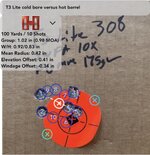
Gun #7 is the 308 used for the scope evaluations- it has hundreds of groups from cold and hot barrels on this forum, it has zero change cold to hot. Again, here is it with different ammo on another day with cold and hot overlaid-
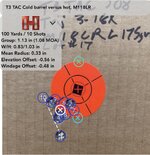
To detect minute changes, and in this case it’s changes that fall outside the expected variability (which did not happen with any rifle here) you need a much larger sample size. It would start at 30 shots per rifle, per group to get to 95% confidence, and really we would need multiple groups from each. It becomes prohibitive quickly, and quite frankly digresses into irrelevancies for any practical use.
We could repeat the experiment a hundred times over with the same targets, and at the end of those 100 groups the two groups, cold and hot, would look identical. They would be a near perfect circle with a large hole in the center and less shots the farther you move from center. It’s been done consistently.
These are both the same rifle with different ammunition, human fired from sandbags, using an Oehler and acoustic to track and log each shot. 100 shots per group. There are a bunch of cold barrel shots, a bunch of extremely hot barrel shots, and a bunch in the middle- about a third for each. The difference in cold barrel 10 round group size and location between cold and hot was less than 1/10th on an MOA- totally inside of random distribution.

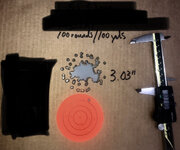
Yes, that could be mirage, but mirage is also a byproduct of heat. So it seems one could say that heat CAN (not necessarily WILL) open up groups, even if mirage is the true culprit. Mirage wouldn’t be there if not for the barrel heat. Which is then perhaps to say that when shooters state their groups often open up with heat, it’s not all “nonsense”? It can happen. It’s shown here.
Yes you can say that, however that is not why or what people say. Mostly people use a barrel heating up as an excuse for why they don’t shoot more shots to check zero and to confirm group size. The “the only shot that matters is the cold bore, and the first shot always lands into the same spot”. It’s simply not true.
These statements are made by and large by people that do not have anywhere near sufficient data to come to that conclusion. The only way to see a minute change with a properly built rifle system is to shoot 30-50 cold bore/first shots of the day into a single group, and then 30-50 shots of a warm/hot barrel into a single group, then overlay and see the differences- as in the two 100 shot targets above.
I’m not trying to argue. I’m just trying to understand why what I’m seeing in these test results differs from what you’re saying.
You can argue as much as you want- constructive argumentation is required for learning. I appreciate it. The base differences seen here are inside the standard expected variation of these rifles and ammunition, and therefore can not be stated to be “different” due to barrel heat. There
may be minute differences, but that can not be stated without further testing. And, those differences would not be usable/functional as we are limited by what we can adjust out and account for.
In order for there to be a “difference”, the difference must fall outside of normal distribution. That is, if a rifle system is constantly about a 1 MOA rifle- say 10x10 groups cold bore shots, the average was 1 moa, and the largest group was 1.3 MOA- but when fired 10 shots in a row (warm/hot barrel) the group was 2 moa. And then when a second 10 shot hot barrel group was fired it was 1.6 moa- then, yes you could say that the groups from that rifle open up when it gets hot. However, if the first hot barrel group was 1.2 moa, and the second was 1.3 moa: no, you could not say that the groups get larger when the barrel heats up- both are inside the true cone.
I’ve owned exactly one rifle out of many dozen in my life that most certainly was effected by heat. A Weatherby Vanguard 25-06. After a few shots if not allowed to thoroughly cool, it absolutely would spray bullets all over the place.
And that’s a thing. But it’s a bad barrel/improperly built/assembled rifle thing, not a barrels “walk” when hot thing. It points to a mechanic problem with the rifle system that should be addressed.
All of this is revolving around a best practices/optimized/functional/whatever way to zero and check zero, check group sizes, load development, load comparison, diagnose rifle/equipment problems, etc.
It’s not a rigorous white paper on
“weather barrel mirage causes up to a .18683 MOA shift in apparent target location through a scope” thing. It’s a
“to save time, money, energy, and get usable data- lay down, fire ten rounds, find the true center of all ten rounds (do not discount shots), adjust from that center, fire five to ten more shots, if needed make a small adjustment: you are now zeroed. If the ten round groups are too large for you, change bullet or powder- small changes won’t make large differences” thing.





